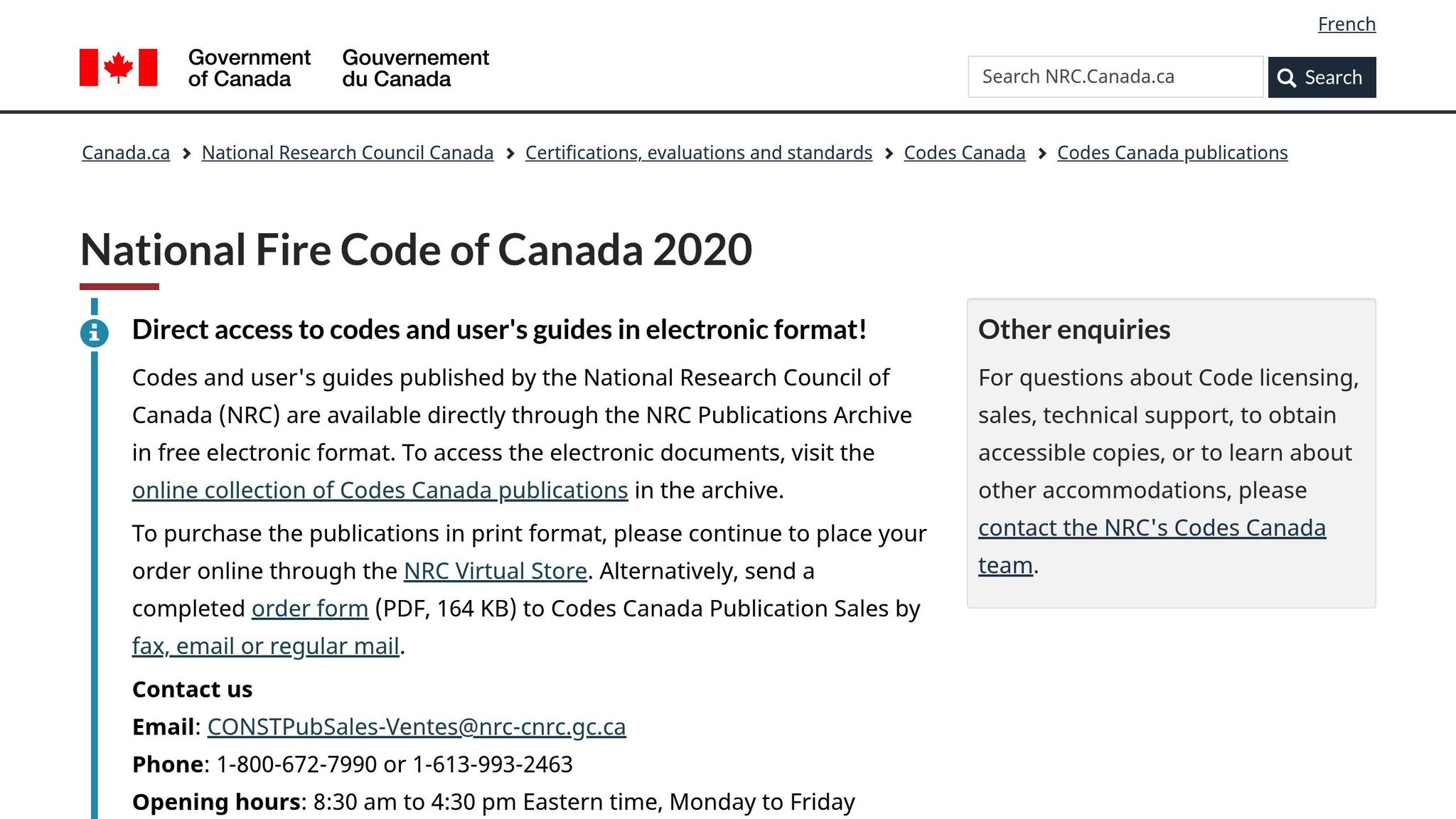Fire safety in multi-unit properties is non-negotiable. In Nova Scotia, property owners must follow strict regulations to protect tenants and reduce risks. Key practices include:
- Regular Inspections: Multi-unit buildings require scheduled fire inspections based on their size and use. Regular checks for fire doors, smoke alarms, and electrical systems are vital.
- Fire Safety Plans: These must align with the National Fire Code and include evacuation routes, maintenance schedules, and emergency procedures.
- Tenant Education: Educate tenants on fire safety protocols, evacuation plans, and hazard prevention, especially for kitchen and electrical safety.
- Emergency Preparedness: Conduct fire drills, maintain clear escape routes, and collaborate with local fire departments to improve response times.
- Retrofitting Older Buildings: Ensure compliance with updated fire safety standards by addressing fire-resistant materials and system upgrades.
Follow Along with a Fire Inspection
Nova Scotia Fire Safety Regulations for Multi-Unit Properties
Nova Scotia has a detailed fire safety framework designed to protect tenants and ensure property owners meet their obligations. This framework includes the Fire Safety Act, Building Code Regulations, and Fire Safety Regulations, all of which establish clear responsibilities for multi-unit property owners.
The updated Fire Safety Regulations (O.I.C. 2025-77, N.S. Reg. 60/2025), effective April 1, 2025, introduced stricter requirements and clarified compliance processes [2].
Mandatory Inspection and Compliance Schedules
Municipalities are required to inspect multi-unit residential buildings (those with more than three units) on a set schedule. For example, buildings classified as assembly occupancies must be inspected every three years. If a property is found to be non-compliant, the inspection fee is $96.50 per hour, plus any associated costs [2].
For smaller residential properties with three or fewer units, inspections are only mandated when complaints about fire or life safety issues are raised by government departments, fire services, or police agencies [2].
Halifax has implemented a proactive Fire Safety Maintenance Inspection (FSMI) Program, which uses standardized checklists to ensure consistent inspections across different building types, including multi-unit residences [3].
In buildings with large occupancies - such as assembly spaces for over 200 people, detention facilities for more than 50, or care residences - owners must appoint a chief fire warden. These wardens are responsible for conducting biannual hazard inspections and submitting written reports. Property owners are required to keep these reports for seven years and provide them to fire officials upon request [2].
These inspection schedules complement the comprehensive fire safety plans mandated by the National Fire Code of Canada.
Fire Safety Plans and National Fire Code Requirements

Fire safety plans in Nova Scotia align with the National Fire Code of Canada, with adjustments to address local needs [2]. Most buildings and occupancies must implement these detailed plans.
In Halifax, multi-unit rental properties must develop fire safety plans in collaboration with Halifax Regional Fire & Emergency and other regulatory bodies [5]. These plans are crucial for ensuring that fire safety systems and equipment are used effectively while outlining procedures to protect building occupants [5].
For buildings equipped with fire alarm systems as required by the National Building Code, emergency procedures must be clearly provided [5]. Halifax Regional Fire & Emergency offers fire plan templates to help property owners prepare their plans [5].
The plans should include:
- Emergency procedures and evacuation routes
- Maintenance schedules for fire safety equipment [5]
If fire protection systems need repairs, owners must address them immediately. In cases where a system is shut down for more than two hours, the fire department must be notified. Occupants must also be informed if fire alarms or detection systems are inoperative [2]. For sprinkler systems, additional measures must be taken to protect the building if the system is out of service for more than six hours [2].
When Retrofitting Is Required for Older Buildings
Older multi-unit properties are subject to specific retrofit requirements outlined in Part 8 of the Fire Safety Regulations. These rules apply to boarding, lodging, and rooming houses that:
- Provide accommodations for more than three people for payment
- Are no taller than three storeys or 600 square metres
- Lack exclusive bathroom and kitchen facilities for lodging rooms
- Were used for boarder/lodger accommodations before April 1, 2025 [2]
The regulations take into account the materials used in older buildings. For example:
- Existing floor assemblies with materials like lath and plaster, gypsum board, or noncombustible material ceilings meet fire separation requirements [2].
- Walls in sleeping areas with lath and plaster or gypsum wallboard membranes are considered compliant with fire-resistance ratings [2].
Solid core wood doors, 45 millimetres thick, with a 42-millimetre solid door frame, can meet closure requirements between sleeping areas and corridor exits, even without a certified fire-protection rating [2].
Buildings constructed before March 13, 1987, may use alternative compliance methods outlined in Schedule D of the Nova Scotia Building Code Regulations. Heritage buildings are also granted additional flexibility under the regulations [4].
The term "retrofit" refers to making changes to occupied buildings to add fire safety features required by fire officials. This does not include voluntary renovations initiated by the owner, which must still comply with the Building Code [2].
Retrofitting ensures that older buildings meet modern fire safety standards, providing better protection for tenants and simplifying compliance for property owners.
Core Fire Safety Practices for Multi-Unit Properties
Nova Scotia's fire safety regulations set a high standard for managing multi-unit properties. To ensure safety, property managers must focus on three key areas: prevention, detection, and evacuation. These practices are essential for safeguarding lives and property.
Regular Fire Safety Inspections
Frequent inspections are critical to identifying and addressing fire hazards before they become serious risks. The inspection schedule varies depending on the building type, but multi-family properties generally require checks every one to three years, as per local fire codes [8]. Buildings with higher risk factors demand even more frequent assessments [9].
"Maintaining fire door assemblies in good working condition is essential to ensuring they perform their life-saving functions during a fire. According to NFPA 80, fire door assemblies must undergo annual inspections to verify that they comply with safety standards and are fully operational." [6]
Monthly inspections should focus on specific fire risks, such as damaged fire separations, improper storage in garages or sheds, and lint build-up in laundry facilities [7]. Key areas like furnace rooms and overloaded electrical systems also require close attention [7].
Fire doors are a critical component of fire safety. Inspect them to ensure they close properly, remove any wedges or props, and check the seals, latches, and door closers for proper operation [6]. Past incidents have demonstrated the devastating consequences of poorly maintained fire doors, which can allow fire and smoke to spread unchecked [6].
Smoke and carbon monoxide alarms should be tested every month, with batteries replaced annually. Keep a detailed record of all maintenance activities [7]. Additionally, ensure that corridors, stairwells, and exterior areas remain clear of obstructions to allow for safe emergency egress [7].
While inspections are vital, maintaining detection and suppression systems is equally important.
Fire Detection and Suppression Equipment
Effective fire detection systems include smoke and heat detectors connected to a central fire alarm system [10]. These systems must be tested regularly, and batteries should be replaced annually to ensure reliability [11].
Fire suppression systems, such as sprinklers (both automatic and water mist types), fire pumps, and portable fire extinguishers, are essential for controlling fires before they escalate [10]. Regular maintenance of hoses, nozzles, and connections ensures these systems remain in peak condition [10].
A detailed fire safety plan should outline maintenance procedures for all fire protection equipment [12]. Fire extinguishers must be fully charged and, where necessary, approved for marine use [11]. Keep all fire protection equipment accessible and maintain records of activities, including specialized tasks like compressed air blow-through maintenance for CO₂ systems [11].
Emergency Exits and Escape Routes
Clear and accessible escape routes are critical during an emergency. Egress doors should meet specific requirements: they must be at least 81 cm wide, swing outward, and operate without the need for keys or special tools [14]. Door thresholds should not exceed 13 millimetres in height and must be bevelled for safe passage [14].
Panic hardware on exit doors should feature a push-pad or crossbar that covers at least half the door's width and opens with minimal force - no more than 66 Newtons (15 pounds) [14]. This ensures that occupants can quickly and safely exit, even under stress.
Fire exits must lead directly to a safe area and be clearly marked with appropriate signage [13]. Escape routes should take the shortest, safest path and provide at least two independent exits from each part of the building [13]. Keep these routes free from obstructions and flammable materials to ensure they are always ready for use [13].
Regular inspection and upkeep of emergency exits and escape routes are vital. These measures not only protect tenants during emergencies but also help property owners meet their legal responsibilities.
Tenant Education and Fire Preparedness
Fire safety equipment alone isn’t enough to keep tenants safe in an emergency. To truly protect lives and property, tenants must know how to respond effectively when danger arises. That’s why tenant education is just as important as having reliable fire detection and suppression systems. Informed tenants can help reduce the impact of fire incidents, and property owners are key players in providing consistent education on fire safety and emergency protocols.
Recent fire events that have caused extensive property damage highlight just how crucial tenant education is.
"Property owners are responsible for their occupants and therefore play a vital role in fire safety education." – Lee Mullins, Safety and Compliance Specialist, Barge Design Solutions [15]
Teaching Tenants Fire Safety Procedures
From day one, new tenants should be introduced to essential fire safety practices. This includes understanding evacuation routes, how to operate alarms, and how to report hazards. Including fire safety rules in lease agreements and distributing them to all residents ensures everyone has access to this critical information.
Tenants should be encouraged to familiarize themselves with both primary and secondary escape routes and practice using them. These routes should lead to a pre-determined assembly point. Additionally, tenants need to know how to use a fire extinguisher correctly, following the PASS method (Pull, Aim, Squeeze, Sweep). However, they should also understand that calling emergency services takes priority over attempting to fight a fire.
Kitchen safety is another key area to address, as cooking fires are a frequent cause of residential fires. Tenants should be reminded to keep flammable items away from stovetops and heaters, never leave cooking unattended, and clean cooking surfaces regularly. Electrical safety is equally important - encouraging the use of UL-listed power strips and avoiding overloaded outlets can significantly lower risks. For properties with smoking areas, establishing clear guidelines and promoting safe candle use (or flameless alternatives) can further reduce hazards.
Effective Methods for Fire Safety Education
Keeping fire safety top of mind requires ongoing communication. Digital signage, regular emails, and newsletters are great tools to remind tenants of protocols. Periodic fire drills help tenants become familiar with escape routes and prepare them to act calmly under different conditions. Seasonal reminders - especially before holidays or during extreme weather - are another effective way to reinforce safety tips.
Posting bilingual flyers in high-traffic areas like mailboxes or laundry rooms ensures the message reaches a broader audience. Optional workshops or training sessions can also be valuable. Hands-on experiences, like fire extinguisher demonstrations or virtual reality simulations, make the information more engaging and easier to retain. Inviting local fire department personnel or third-party experts to lead training sessions adds credibility and brings in specialized knowledge.
Clear Communication and Safety Signage
Visible evacuation maps and building-specific emergency contacts should be displayed in common areas, ensuring they’re easy to find even in low-light conditions.
Providing accessible systems for tenants to report hazards - such as missing smoke detectors, blocked exits, or malfunctioning emergency lights - helps address issues promptly. Offering multiple reporting options, like phone, email, or an online portal, ensures every tenant can easily flag concerns.
Regular education builds safer habits, strengthens awareness, and fosters a community that knows how to act when seconds matter most. By adopting a thorough and consistent approach to tenant education, property owners can create a stronger fire safety culture within their buildings. These practices also lay the foundation for more comprehensive emergency preparedness, which will be explored in the next section.
sbb-itb-16b8a48
Emergency Preparedness and Response Planning
Educating tenants is a good start, but property owners also need a solid emergency response plan in place. This means detailed planning, regular practice drills, and fostering strong connections with local emergency services. Quick and effective action during emergencies can make all the difference. Let’s dive into key aspects like fire drills and evacuation strategies to ensure readiness.
Fire Drills and Evacuation Plans
In many parts of Canada, regular fire drills are a legal requirement. Hosting annual fire drills with tenants is an excellent way to practice evacuation routes and identify areas for improvement.
"Conduct Fire Drills - Organize annual fire drills in your buildings in collaboration with tenants to practice evacuation procedures. Simulating emergency situations can help tenants familiarize themselves with escape routes and proper procedures in the event of a fire, and can help Property Managers work through any 'hiccups', so the process can be smoothed out in a real emergency." - Tami Bergen, Contributing Author, Onyxcm.ca [17]
Every unit should have clearly defined primary and secondary evacuation routes, along with a designated assembly point outside the building. During these drills, property managers should observe how tenants respond and make adjustments to improve the process. For properties without alarm systems, it’s critical that all occupants evacuate immediately when emergencies arise.
It’s also essential to keep common areas clear and ensure evacuation routes are unobstructed. Beyond the drills, building strong partnerships with local fire departments can significantly enhance emergency readiness.
Working with Local Fire Departments
Collaborating with local fire departments is a smart way to improve response times and strengthen overall fire safety. Regular meetings and updates help align emergency plans with the broader safety measures you’ve already put in place.
By coordinating training sessions, fire department personnel can familiarize themselves with the property’s layout, unique risks, and existing safety features. This helps ensure a more efficient response in real emergencies. For instance, National Grid Renewables worked with multiple fire departments during an emergency action drill at their Prairie Wolf Solar facility. This partnership led to practical changes, such as better site navigation with new exit signs and the creation of a helicopter landing zone for medical emergencies [16].
"These safety drills are a great opportunity to meet the people who would be responding to an emergency, and to work together towards the best possible safety protocols." - David Ureno, Plant Manager III at National Grid Renewables [16]
Property owners should also share building layouts, access points, and security protocols digitally to give emergency teams quick access to critical information. Regular meetings can address any updates, new risks, or changes to the property. Fire departments often value these partnerships. For example, after a safety drill, National Grid Renewables donated $4,000 to the Ashmore Fire Department to help upgrade their radio communication systems, improving overall coordination [16].
"If you prepare for the worst, you'll be ready if the moment comes." - Clay Brener, Ashmore Fire Department Chief [16]
Record-Keeping for Emergency Preparedness
Keeping detailed records is a vital part of emergency preparedness. Documenting drills, maintenance, and inspections not only proves compliance but also provides insights for improvement.
Monthly inspection logs should cover key fire safety equipment like extinguishers, alarm systems, emergency lighting, and sprinkler systems. Note both their condition and any maintenance performed. Make sure emergency contact information - such as the property’s address and specific instructions for responders - is clearly posted near telephones.
Fire safety plans should outline evacuation procedures, equipment maintenance schedules, and strategies to reduce fire damage. These plans should also define staff roles, such as fire wardens, and include records of their training on equipment use and evacuation protocols.
Building Emergency and Evacuation Teams are crucial for coordinating responses during a crisis. By creating building-specific emergency plans and maintaining accurate records, these teams ensure that everyone is better prepared to act quickly and effectively when it matters most.
A well-rounded approach to emergency preparedness is the backbone of fire safety in multi-unit properties, ensuring both tenant safety and property protection.
Integrated Construction Approaches to Fire Safety
Fire safety starts at the construction stage. By embedding safety measures from the initial planning phase through to project completion, builders can avoid costly retrofits and ensure compliance with modern safety codes. This approach aligns perfectly with the fire safety practices discussed earlier.
Why Integrated Design-Build Models Work
Traditional construction methods often separate the design and building processes, increasing the chances of errors, omissions, and expensive last-minute adjustments. An integrated design-build model, however, encourages collaboration from the outset, ensuring that fire safety elements - such as fire-resistant materials, efficient suppression systems, and well-planned evacuation routes - are seamlessly incorporated into the project.
For instance, early integration enables teams to choose fire-resistant materials, install advanced sprinkler systems, and design clear escape routes complete with emergency lighting. Modern sprinkler systems highlight the importance of this proactive planning. In residential buildings, activated sprinkler systems are 97% effective in controlling fires [18]. When these systems are part of the initial design, they align effortlessly with the building’s infrastructure and other safety measures.
The financial benefits of a coordinated approach are equally compelling. Traditional methods often result in budget overruns of 30–60% and project timelines that stretch from 8 months to over 18 months due to poor coordination among contractors. By contrast, integrated models streamline processes, saving both time and money.
Helio Urban Development: A Case in Point

Helio Urban Development showcases how integrated construction benefits property owners in Nova Scotia. As the province’s only design-build firm specializing in rental properties with four or more units, Helio combines the expertise of planners, architects, engineers, and builders under one contract. This ensures that fire safety and regulatory requirements are built into the project from day one.
Currently working on 31 units, with 131 more planned, Helio offers a fixed-price model of C$160,000 per unit. This price includes comprehensive fire safety measures and guarantees project completion within six months. To reinforce their commitment, Helio imposes penalties of C$1,000 per day for delays. This streamlined approach not only prevents cost overruns and delays but also strengthens the fire safety framework of each building, setting a higher standard for construction in the region.
Conclusion
Strong fire safety practices are crucial for protecting tenants and safeguarding property owners from potential risks. Ensuring fire safety in multi-unit buildings demands ongoing, collaborative efforts across all aspects of property management. By focusing on regular inspections and educating tenants, property owners can create safer living spaces while also reducing their liability.
Data shows that 74% of fires in multifamily buildings start in cooking areas[21]. This highlights how essential it is to educate tenants about kitchen safety. Ignoring fire safety can lead to devastating consequences, including property damage, loss of life, legal issues, and higher insurance premiums[20][1].
At the heart of any effective fire safety plan are regular inspections and maintenance. Keeping accurate records not only ensures compliance but also provides legal protection if challenges arise[19][21].
In addition, incorporating fire safety into the design phase of a building can prevent costly retrofits later on. By working with builders who prioritise coordinated planning, property owners can ensure fire safety systems are seamlessly integrated into the building’s infrastructure, meeting modern codes and enhancing safety for all residents.
Taking a comprehensive and proactive approach to fire safety doesn’t just protect investments - it saves lives.
FAQs
How does an integrated construction approach improve fire safety for multi-unit properties?
An integrated construction approach weaves fire safety into the very fabric of a building's design. By planning critical systems - like fire alarms, sprinklers, and fire-resistant materials - as part of a unified strategy, this method eliminates the risk of oversights or delays that can arise when these elements are addressed independently.
When fire safety measures are coordinated from the outset, it ensures adherence to safety regulations, speeds up the implementation process, and strengthens overall protection for occupants. This approach doesn’t just safeguard lives - it also brings reassurance to both property owners and tenants, knowing that safety has been prioritized from the ground up.
What are the best ways for property owners to educate tenants about fire safety and emergency preparedness?
Educating Tenants About Fire Safety in Multi-Unit Properties
Making sure tenants understand fire safety is a crucial step in keeping everyone safe and prepared. For property owners in Canada, this starts with clear communication about fire prevention and emergency procedures. Use written instructions, visual aids, and regular reminders to keep these important messages front and centre. Key topics to highlight include:
- Proper use of smoke and carbon monoxide alarms
- Keeping escape routes clear at all times
- Familiarity with the building’s alarm systems
To take it a step further, consider organizing fire drills and safety workshops. These hands-on activities give tenants a chance to practise emergency responses, helping them feel more prepared if a fire ever occurs.
Another effective strategy is to provide tenants with a simple, easy-to-read emergency plan. Tailor this plan to the building’s specific layout so everyone knows exactly what to do and where to go in an emergency. By revisiting these safety measures regularly, you can help establish a strong culture of awareness and readiness throughout your property.
What fire safety upgrades are required for older multi-unit buildings in Nova Scotia?
In Nova Scotia, older multi-unit buildings undergoing retrofits or repairs are required to meet current fire safety standards. This typically involves upgrading fire alarms, sprinkler systems, and incorporating fire-resistant materials. These measures align with the Fire Safety Regulations and the Nova Scotia Building Code to ensure buildings are safe and up to standard.
For renovations or repairs after fire damage, property owners must adhere to the latest safety requirements. This process includes securing the necessary permits and ensuring all fire protection systems meet provincial safety standards. Working with certified professionals is essential to guarantee both compliance and the safety of the building's occupants.



